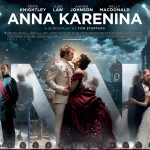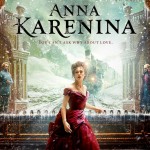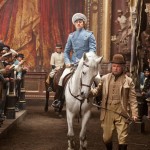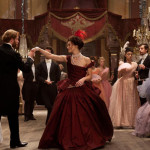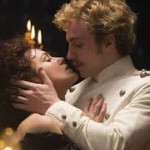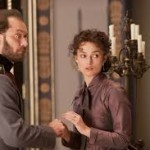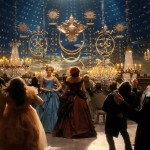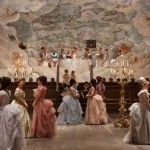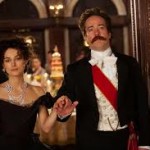I’m never quite sure whether it’s a good thing or not, but I will confess to never having read Tolstoy‘s classic novel Anna Karenina, nor indeed to have watched the previous film versions, of which there are, in some form, language or adaptation, a grand total of 16 (1911, 14, 15, 27, 35, 48, 53, 60, 67, 76, 77, 85, 97, 2000, 2012 and 2013.)
That makes this epic love story set against the dying years of Imperial Russia roughly the equivalent of a Shakespearean historical drama, in that the story has been performed every which way so directors feel it their duty to come up with a new interpretation, possibly though not necessarily to become the definitive version but to advance the art of portraying the same characters and events more indelibly than in previous versions, thereby giving future directors something to take into account when devising their next generation interpretations.
And yet, messing with the masters is a dangerous game to play. This is a tragedy and a tragedy requires gravitas and depth in the Greek tradition. Many would argue that this is a story that should only ever be played straight and without editing, manipulation or undignified setting. Mind you, there are those who would say the same about playing with time zones and other variants on classic Shakespeare, though most are judged by the critics on their merits.
So what do the critics make of Joe Wright‘s 2012 version of Tolstoy’s masterpiece? I’m happy to report that they and I formed many of the same conclusions, namely that the production looks ravishing, its sets and landscapes sublime, its costumes breathtaking, its cinematography utterly glorious, its cast divine, its Tom Stoppard script impeccable, and its production values up there with the very finest Hollywood has to offer. Make no mistake, the quality of the ingredients on offer are spellbinding.
…And yet, taken as a whole the movie fails to hit the spot by virtue of being so heavily over-stylised and desanctified by Wright that you wouldn’t have been at all surprised had Keira Knightly burst forth into a chorus of The Trolley Song on the train back to Moscow. The movie is played within the confines of a theatrical production, opening out at various times, only to return to the motif of the proscenium arch at regular intervals, which you could perhaps understand and forgive if the roots of the play were in theatre rather than in a Russian novel.
From my perspective, it’s an unnecessary and irritating distraction, as if the director has a knowing wink at the audience and tongue firmly pressed into his cheek. We all know it’s a story, he seems to be saying, but the characters don’t – they are required to act out their story regardless.
It seems like there is too much going on, too much invention and pointless detail that could easily have been airbrushed from the shot on the grounds that less is very often more. The evidence is readily apparent since this movie works best when at its simplest, like the glorious lingering shot on the ruined Anna very near the end, spoiled only by interjections of turning train wheels. The whole point is that if you were going to do anything to the source material it would be to cut back on the ephemera and focus instead on the searing human emotion.
There are other subplots, but the story concerns the eponymous Anna’s enduring love for Count Vronsky while married to dour and passionless Karenin, at the cost of her place in respectable Russian society, and her life when Vronsky eventually rejects her. This is the heartbeat of the movie, and yet Wright chooses on so many occasions to gild the lily and place style over substance. To illustrate the point, let me quote from Wikipedia:
Upon its release, the film received positive reviews from critics, with some praising the cast – particularly Knightley – and the production design but criticising the script and Wright’s apparent preference for style over substance. The film received an average review score of 61 percent according to review aggregatorRotten Tomatoes. Metacritic reported an average score of 63 out of 100, based on 41 reviews and classified the film as “generally favorable”.
Oliver Lyttleton of The Playlist awarded the film a B+ and called the picture a “bold reimagining” of the classic novel, comparing Wright’s vision to the films of Powell and Pressburger. He noted how Knightley “continues to go from strength to strength” and also praised Law as “excellent”. Even though he speculated that “the film is going to divide people enormously”, he concluded it was one to “cherish despite its flaws”. Ian Freer of Empire awarded the film four stars out of five and was effervescent in his praise for Wright and the final result: he said “Anna Karenina militantly doesn’t want to be just another costume drama; it attacks the heavyweight concerns of Russian literature (hypocrisy, jealousy, faith, fidelity, the pastoral vs. the urban, huge moustaches) with wit and verve; most exciting of all, it is filmmaking of the highest order, channeling every other art form from painting to ballet to puppetry while remaining completely cinematic”. He lauded the entire cast for their work yet concluded that “this is really its director’s movie”.
In The Observer Jason Solomons also called Knightley “superb”, and declared that the film “works beautifully…[it is] elegant and exciting [and] …incredibly cinematic”. Leslie Felperin of Variety was more reserved in her praise for the film, observing that although Wright “knows how to get the best from Knightley” and noting that the film was technically “glorious”, it was also “unmistakably chilly” in the storytelling. The Daily Mirror singled out Knightley as “excellent” and lauded Wright for “offer[ing] a fresh vision of the Tolstoy classic”, concluding the picture to be “with its beautiful cinematography and costumes… a real success”.
Others were less impressed with the film and Wright’s take on such a classic text. The Hertfordshire Mercury conceded that “costumes and art direction are ravishing, and Seamus McGarvey’s cinematography shimmers with rich colour”, but ultimately found there to be “no obvious method behind this production design madness”. Stella Papamichael of Digital Spy also awarded the picture only two stars out of five, commenting that “the third time isn’t such a charm for director Joe Wright and muse Keira Knightley”. Although she found the actress “luminous in the role” she criticised Wright for “outshining” his star and affecting the narrative momentum by “favouring a glossy look over probing insights into a complicated character”. Neil Smith of Total Film also awarded the film two out of five stars, lamenting the fact that Wright’s elaborate stage design “pull[s] the attention away from where it should be… [and] keeps [us] at arm’s length, forever highlighting the smoke, mirrors and meticulous stage management that have been pressed into service to make his big idea a reality”. He also dismissed Knightley’s performance as “less involving” than her “similar” turn in The Duchess. Richard Brody of The New Yorker criticised Wright for diverging from Tolstoy, without adding anything beyond superficialities in return: “Wright, with flat and flavorless images of an utterly impersonal banality, takes Tolstoy’s plot and translates it into a cinematic language that’s the equivalent of, say, Danielle Steel, simultaneously simplistic and overdone.”
Granted there is a range of opinion among that sample, but I agree most strongly with the critical comments, notably that the director intervenes where he and his camera should step back and allow the actors to flourish, to take the literal stage by themselves. Theirs should be the interpretation that matters most.



